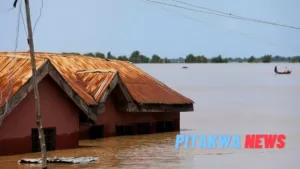The Nigeria Flood: What Happened, Why and What Needs to Be Done

Heavy rains caused by a convergence of weather patterns have led to the worst floods in Nigeria in 20 years. The catastrophe has killed at least 200 people and displaced more than one million as well as destroyed homes and businesses. Nigeria is prone to natural disasters, especially during the rainy season from June to October when its tropical climate comes alive with heavy thunderstorms and rain. Several major cities are located in flood-prone areas. In 2017 alone, the country experienced four different floods:
Maroua & Yagayamu Flood: July 2017
The Maroua Flood, which started in the city of Maroua in the Far North region of Cameroon, killed at least 35 people and displaced thousands of others. This flood happened about a month before the Yagayamu Flood, which occurred in the Nigerian town of Yagayamu, about 100km north of Makurdi, the capital of the Benue state. According to the National Emergency Management Agency, the flood was triggered by the heavy rains from mid-July to mid-August 2017, killed at least 56 people and displaced thousands of others.
Taraba Flood : August 2017
The Taraba flood started in the third week of August when over 30 people lost their lives and tens were injured. This was triggered by the heavy rains that started in the second week of August and continued until the end of the month. Heavy monsoon rains caused flooding in certain parts of the state. The floods were worsened by the overflow of the Niger River and the absence of effective drainage systems in the affected areas
Kano Flood : September 2017
The Kano Flood was also triggered by the heavy rains that started in the second week of August and continued until the end of the month. Heavy monsoon rains caused flooding in certain parts of the state. The floods were worsened by the overflow of the Niger River and the absence of effective drainage systems in the affected areas.
Niger Delta & Baga Flood : October 2017
The Niger Delta flood started in the first week of October and caused the death of at least 21 people, the evacuation of thousands, and the destruction of several homes, schools, and businesses. The flood was triggered by the heavy rains that started in August and continued until the end of the month. The Baga flood was triggered by the heavy rains that started in the first week of October and continued until the end of the month. Heavy monsoon rains caused flooding in certain parts of the state. The floods were worsened by the overflow of the Niger River and the absence of effective drainage systems in the affected areas.
Thick Clouds of Dense Smog for Months Now
The floods have been accompanied by thick clouds of dense smog that have restricted visibility and caused respiratory problems for hundreds of thousands of people. The smog is mainly due to the burning of forests in the northern part of the country to make way for farming. Nigeria has among the highest deforestation rates in the world, with around 10,000 hectares of forests being lost every year. This has resulted in ground soil erosion and increased flooding during the rainy season. The destruction of forests has also affected the country’s ability to produce enough food. The government has tried to combat deforestation by implementing a ban on charcoal production, which is one of the leading causes of deforestation. But the government’s efforts have been hampered by a lack of funding.
Nigerian’s Struggle with Flood Management & Drainage System
Nigeria has had a long struggle with flood management and drainage systems. One of the major factors that cause flooding in the country is poor drainage management. The drainage systems in major Nigerian cities, including the capital city of Abuja, are poorly managed. Because of this, floodwaters from nearby rivers are not effectively channeled away from residential areas. As a result, residents are often forced to flee their homes when the rivers nearby overflow their banks due to heavy rain. Another factor that has led to flooding in the country is deforestation. By destroying the country’s forests, the government has also reduced the ability of trees and shrubs to absorb rainwater and prevent floods. Since the 1970s, the government has tried to address flooding challenges by constructing dams. But due to corruption and mismanagement, these dams were never completed and were abandoned mid-way through construction.
Recommendation for The Future
To better combat the floods and reduce their effects, the Nigerian government should engage in several preventive measures, including the following: – Strengthen flood and drainage management systems in major cities: The Nigerian government should implement effective flood and drainage management systems in major cities, such as Kano, Abuja, Rivers, Bayelsa, and Makurdi. This can be done through the construction and maintenance of dams, building a strong network of canals, and reinforcing bridges. – Develop an effective agricultural policy: The government should implement an effective agricultural policy, including the provision of subsidies for fertilizers and seeds, the provision of low-interest loans, and the provision of insurance for crop damage. – Protect the country’s forests: The government should create awareness about the importance of protecting the country’s forests for reducing flooding. – Secure funding for flood preparation activities: The government should secure funding from both domestic and foreign sources for flood preparation activities. – Collaborate with foreign agencies: The government should collaborate with international agencies, such as the United Nations, the African Union, the European Union, and the Asian Development Bank, as they have the technical expertise and financial resources that can be used to address flood management challenges in the country.
Urgency
The floods have led to the death of over 200 people, the displacement of more than one million, and the destruction of homes and businesses. It is therefore important to take steps to reduce their impact and ensure that they do not lead to loss of lives and unnecessary suffering. The government should therefore start taking measures to reduce the effects of flooding by taking steps such as strengthening flood and drainage management systems in major cities, developing an effective agricultural policy, and protecting the country’s forests.






